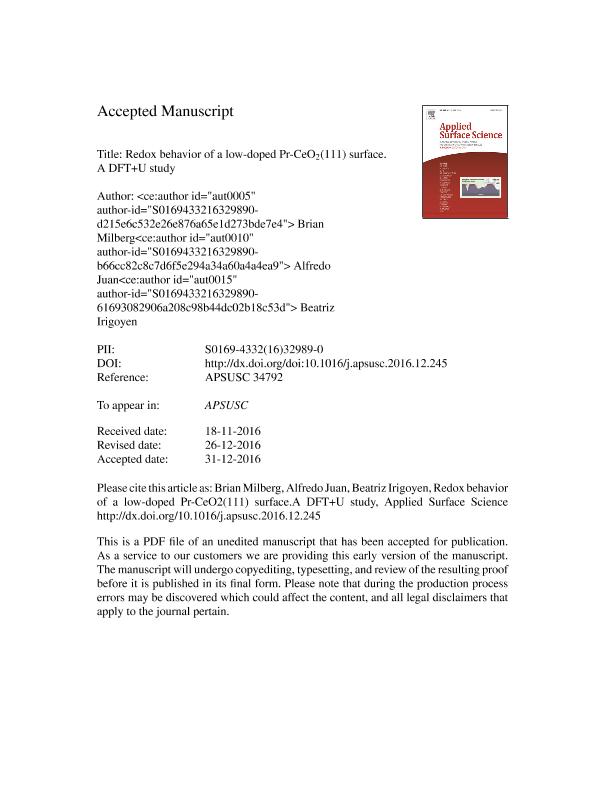Mostrar el registro sencillo del ítem
dc.contributor.author
Milberg, Brian
dc.contributor.author
Juan, Alfredo

dc.contributor.author
Irigoyen, Beatriz del Luján

dc.date.available
2018-11-05T19:04:08Z
dc.date.issued
2017-04-15
dc.identifier.citation
Milberg, Brian; Juan, Alfredo; Irigoyen, Beatriz del Luján; Redox behavior of a low-doped Pr-CeO2(111) surface. A DFT+U study
; Elsevier Science; Applied Surface Science; 401; 15-4-2017; 206-217
dc.identifier.issn
0169-4332
dc.identifier.uri
http://hdl.handle.net/11336/63655
dc.description.abstract
In this work, we investigated the redox behavior (donation and replenishing of oxygen) of a low praseodymium (Pr)-doped CeO2(111) surface. We considered a 3.7 at.% Pr doping and performed density functional calculations using the GGA formalism with the ‘U’ correction on Ce(4f) and Pr(4f) orbitals. Our results indicate that Pr doping promotes oxygen donation by lowering the energy necessary to form surface anionic vacancies. When the Ce0.963Pr0.037O2(111) surface donates one oxygen, the two excess electrons locate on Pr and Ce cations and reduce them to Pr3+ and Ce3+ ones. Praseodymium doping also favors the activation of O2 molecule on surface O-holes, leading to formation of a superoxide (O2−) radical as well as to reoxidation of the Ce3+ cation to Ce4+ one. Additionally, we used the CO molecular adsorption for testing the reactivity of those superoxide species. The calculations expose the ability of these radicals to oxidize CO forming a CO2 molecule floating on the surface. However, when the superoxide is in the immediate vicinity of Pr dopant a carbonate-type species is formed. Our theoretical results may help to gain insight into redox properties and improved catalytic performance of low-doped Pr-CeO2 solids.
dc.format
application/pdf
dc.language.iso
eng
dc.publisher
Elsevier Science

dc.rights
info:eu-repo/semantics/openAccess
dc.rights.uri
https://creativecommons.org/licenses/by-nc-nd/2.5/ar/
dc.subject
Dft+U
dc.subject
Dioxygen Radicals
dc.subject
Pr-Doped Ceo2
dc.subject
Redox Capacity
dc.subject.classification
Nano-materiales

dc.subject.classification
Nanotecnología

dc.subject.classification
INGENIERÍAS Y TECNOLOGÍAS

dc.title
Redox behavior of a low-doped Pr-CeO2(111) surface. A DFT+U study
dc.type
info:eu-repo/semantics/article
dc.type
info:ar-repo/semantics/artículo
dc.type
info:eu-repo/semantics/publishedVersion
dc.date.updated
2018-10-22T18:02:11Z
dc.journal.volume
401
dc.journal.pagination
206-217
dc.journal.pais
Países Bajos

dc.journal.ciudad
Amsterdam
dc.description.fil
Fil: Milberg, Brian. Consejo Nacional de Investigaciones Científicas y Técnicas. Oficina de Coordinación Administrativa Ciudad Universitaria. Instituto de Tecnologías del Hidrogeno y Energias Sostenibles. Universidad de Buenos Aires. Facultad de Ingeniería. Instituto de Tecnologías del Hidrogeno y Energias Sostenibles; Argentina
dc.description.fil
Fil: Juan, Alfredo. Consejo Nacional de Investigaciones Científicas y Técnicas. Centro Científico Tecnológico Conicet - Bahía Blanca. Instituto de Física del Sur. Universidad Nacional del Sur. Departamento de Física. Instituto de Física del Sur; Argentina
dc.description.fil
Fil: Irigoyen, Beatriz del Luján. Consejo Nacional de Investigaciones Científicas y Técnicas. Oficina de Coordinación Administrativa Ciudad Universitaria. Instituto de Tecnologías del Hidrogeno y Energias Sostenibles. Universidad de Buenos Aires. Facultad de Ingeniería. Instituto de Tecnologías del Hidrogeno y Energias Sostenibles; Argentina
dc.journal.title
Applied Surface Science

dc.relation.alternativeid
info:eu-repo/semantics/altIdentifier/url/https://www.sciencedirect.com/science/article/pii/S0169433216329890
dc.relation.alternativeid
info:eu-repo/semantics/altIdentifier/doi/http://dx.doi.org/10.1016/j.apsusc.2016.12.245
Archivos asociados
